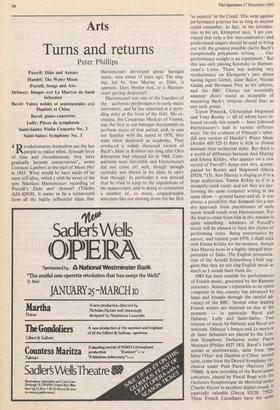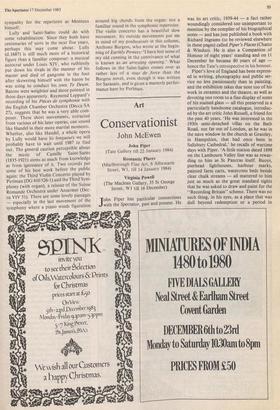Arts
Turns and returns
Peter Phillips
Purcell: Dido and Aenaes Handel: The Water Music Purcell: Songs and Airs
Debussy: Images and Le Martyre de Saint Sebastien Ravel: Valses nobles et sentimentales and Daphnis et Chloe
Ravel: piano concertos Lully: Pieces de symphonic Saint-Satins: Violin Concerto No. 3 Saint-Satins: Symphony No. 3
6 Revolutionaries themselves are the last IN- people to realise when, through force of time and circumstances, they have gradually become conservatives', wrote Constant Lambert at the start of Music Ho! in 1933. What would he have made (if he were still alive, which I wish he were) of the new Nikolaus Harnoncourt recording of Purcell's Dido and Aeneas? (Teledec AZ6.42919). It seems to be a turnaround from all the highly influential ideas that
Harnoncourt developed about baroque music, now about 15 years ago. The sing- ing, led by Ann Murray as Dido, is operatic. Does Homer nod, or is Harnon- court getting desperate?
Harnoncourt was one of the founders of the authentic-performance-in-early-music movement, and he has remained as a recor- ding artist at the front of the field. His or- chestra, the Concentus Musicus pf Vienna, was the first to use baroque instruments to perform music of that period, and, to ears not familiar with the sound in 1970, they were often dismissed as academic. They produced a widely discussed version of Bach's Mass in B minor not long after Otto Klemperer had released his in 1968. Com- parisons were inevitable and Harnoncourt did not come off well, though enough curiosity was shown in his ideas to carry him through. In particular it was noticed that he tried to keep to the stipulations of the manuscripts, and in doing so committed a number of, to many, unpardonable solecisms like not slowing down for the first
'et expecto' in the Creed. This went against performance practice for as long as anyone could remember. In fact, in the introduc- tion to his set, Klemperer says, 'I am con- vinced that only a few instrumentalists and professional singers should be used to bring out with the greatest possible clarity Bach's exceptionally polyphonic writing .... Our performance tonight is an experiment.' But this was only playing Kerensky to Harnon- court's Lenin. There was nothing very revolutionary on Klemperer's part about having Agnes Giebel, Janet Baker, Nicolai Gedda and Hermann Prey as his soloists, and the BBC Chorus (an essentially amateur choir) sound as incapable of mastering Bach's virtuoso choral lines as any such group.
Trevor Pinnock, Christopher Hogwood and Tony Rooley — all of whom have re- leased records this month — have followed Harnoncourt's lead in various different ways. On the evidence of Pinnock's splen- did new version of Handel's Water Music (Archiv 410 525-1) there is little to choose between their orchestral styles. But there is a world of difference between Ann Murray and Emma Kirkby, who appears on a new record of Purcell's Songs and Airs, accom- panied by Rooley and Hogwood (Decca DSDL 713). Ann Murray is singing as if to a large auditorium, Emma Kirkby as if in a modestly-sized room: and yet they are per- forming the same composer writing in the same idiom — ground basses and all. It was always a possibility that demands for a less dry approach from practitioners of early music would touch even Harnoncourt. For the lead to come from him in this manner is quite something. Admirers of Purcell's music will be pleased to have this choice of performing styles. Being conservative by nature, and trained post-1970, I shall stick with Emma Kirkby for the moment, though Ann Murray turns in a highly charged inter- pretation of Dido. The English pronuncia- tion of the Arnold Schoenberg Choir sug- gests that they do not sing English music as much as I would have them do.
1983 has been notable for performances of French music, generated by the Rameau centenary. Rameau's reputation as an opera composer in this country has advanced by leaps and bounds through the careful ad- vocacy of the BBC. Several other leading French writers are featured on disc at the moment — in particular Ravel and Debussy, Lully and Saint-Satins. Two reissues of music by Debussy and Ravel are welcome. Debussy's Images and Le tnartyre de Saint Sebastien are played by the Lon- don Symphony Orchestra under Pierre Monteux (Philips 6527 185). Ravel's Valses nobles et sentimentales, suite from 'Ma Mere l'Oye' and Daphnis et Chloe, second suite, come from the Detroit Symphony Or- chestra under Paul Paray (Mercury SRI 75066). A new recording of the Ravel piano concertos, played by Pascal Roge with the Orchestre Symphonique de Montreal under Charles Dutoit in excellent digital sound, Is especially valuable (Decca SXDL 750, These French Canadians have the same
sympathy for the repertoire as Monteux himself.
Lully and Saint-Saens could do with some rehabilitation. Since they both have centenaries of sorts in the next five years, perhaps this may come about. Lully (d.1687) is still much more of a historical figure than a familiar composer: a musical autocrat under Louis XIV, who ruthlessly put down his rivals in the manner of his master and died of gangrene in the foot after skewering himself with the baton he was using to conduct his own Te Deum. Batons were weightier and more pointed in those days apparently. Raymond Leppard's recording of his Pieces de symphonie with the English Chamber Orchestra (Decca SA 27), suggests that he was a very able com- poser. These short movements, extracted from various of his later operas, can sound like Handel in their more martial moments. Whether, also like Handel, a whole opera by Lully would have its longueurs we will probably have to wait until 1987 to find out. The general caution perceptible about the music of Camille Saint-Saens (1835-1921) stems as much from knowledge as from ignorance of it. Two records put some of his best work before the public again: the Third Violin Concerto played by Perlman (DO 410 526-1) and the Third Sym- phony (with organ), a reissue.of the Suisse Romande Orchestra under Ansermet (Dec- ca V1V 51). There are some lovely passages — especially in the last movement of the symphony where a piano winds figuration around big chords from the organ: not a familiar sound in the symphonic repertoire. The violin concerto has a beautiful slow movement. Its outside movements put me in mind of my predecessor in this column, Anthony Burgess, who wrote at the begin- ning of Earthly Powers: 'I have lost none of my old cunning in the contrivance of what is known as an arresting opening.' What follows in the Saint-Sans comes over as rather less of a tour de force than the Burgess novel, even though it was written for Sarasate, and is given a masterly perfor- mance here by Perlman.







































































 Previous page
Previous page